We have now had our Unity U24IB for just over a year.
What a fantastic and unanticipated year! We’ve driven 16,815 miles and have spent almost 100 days and nights enjoying it. Not since full-timing from July 1998 to June 2000 have we had such inten- sive RV use. I attribute this usage to 1) taking the time necessary to thoroughly understand our preferred RV travel style; 2) investi- gating all of the alternatives available in North America, both new and used; and 3) ordering a coach built to our specifications.
Our Purchase Process
We were downsizing from a 1995 Bounder 34J (34′ 10″ long). It didn’t have any slides but the floor plan was highly compatible with extended periods of use. I full-timed a year before I met Celia and she joined me for a second year before we settled in Bellingham.
Like most people considering downsizing RVs, we didn’t want to give up any more than we had to. From the fall of 2010 to the summer of 2012 we spent a good bit of time defining our travel style and what our goals were in downsizing. Although our prefer- ence was a low mileage RV three to five years old, we consid- ered literally everything, new and used, available in North Amer- ica that would potentially meet our needs.
Our adventures on the road often involve touring for one to eight weeks with short stays in many locations. Convenience is a very important consideration and we were concerned with how multiple use areas and slides would interface with travel mode. During our search process we identified possible RVs and then carefully evaluated them by working through our check list of “how do we do” various things in the RV being evaluated.
We started with looking at the ultimate downsize, B Class con- versions. Several were attractive, but careful consideration brought the reality that they simply didn’t have the room and con- venience we wanted for long trips on the road. After we aban- doned the B Class, we looked at B+ and C Class RVs. Over the first few months, we made a few basic decisions and developed several decision criteria.
The first cut came when we decided on a Sprinter chassis based on economy, reliability, drivability and resale. Then we looked at how various alternatives would fit our evolving decision criteria.
Island bed – The convenience of an island bed (which we had in our Bounder) was important. Neither of us was excited about a corner bed or a bed in a multiple use space that required daily conversion. We thought we wanted a slide, but soon realized that beds in slides usually scored poorly with us because space utili- zation is so defined by the position of the slide. You either have a living area or a bed, never both. Beds in slides would require us to be on the same sleep schedule and, while we usually go to bed at the same time, we seldom get up at the same time. We soon realized that a separate bedroom was a big plus.
Convenient dining – When traveling we have almost all of our meals in our RV. Some floor plans required running the slide out to have access to the dining area. For the noon meal, that meant running the slide out then retracting it after lunch to travel on.
Separate space for bedroom, galley and living area – Multiple use areas always pose compromises. We wanted to avoid as many multiple use areas as possible.
Outside storage – We frequently travel with bicycles and other recreational gear. Hanging our Bike Friday bicycles on a hitch rack in the weather was less than desirable. Space to conven- iently store the things we like to travel with was very important.
We found Unity IBs at three dealers, all of whom were very helpful. Although the dealer in Langley, BC, said he couldn’t sell us a Unity because we lived in the States, he was still very help- ful and spent significant time showing us the features of the Unity. Over several months we spent a total of over seven hours looking at U24IBs at these three dealers before we finally arrived at our specifications. When our research found that the new Unity IB not only fit us better than anything else but also had room for our Bike Fridays in the rear compartment, the decision was easy. We ordered a 2013 U24IB in mid-August from Creston RV.
On Tuesday evening, November 27, we boarded a bus at the airport in Bellingham and headed for a motel near the Vancouver International Airport. The next morning we caught an early flight to Winnipeg. We were introduced to our Unity on Thursday morn- ing the 29th shortly after 8:00.
When we walked into the delivery area I remarked to the gen- tlemen with us, “There ours is.” “How do you know?” he said. “We left off some stripes.” Brad Wall performed the delivery and intro- duction to our new Unity and, despite a minor glitch in specifica- tions (two outlets hadn’t been wired to the inverter as specified) the experience was absolutely first class. One outlet was cor- rected and Brad quickly found a workaround for the second.
An Evaluation of our Specifications
Delete the table – Rationale: Convenience. We noticed when sales people showing us the Unity IB had trouble storing the table under the bed (and getting it back out). We tried it and did no better, so we thought about our comfort level with the table proc- ess. It didn’t pass. The reality was that stowing and retrieving the table was more challenge than we welcomed.
 Carefully evaluating the table, we found that it was in the way when left in place when not in use. With the table in place, it was difficult to get from the cab to anywhere else in the coach. Somehow it seemed to contribute to a feeling of claustrophobia. When the table was stashed under the bed, the mounting plates were stumbling points on the floor and hardly attractive.
Carefully evaluating the table, we found that it was in the way when left in place when not in use. With the table in place, it was difficult to get from the cab to anywhere else in the coach. Somehow it seemed to contribute to a feeling of claustrophobia. When the table was stashed under the bed, the mounting plates were stumbling points on the floor and hardly attractive.
During one of our Unity shopping trips we sat in an IB for almost two hours as we talked about various aspects of the floor plan and how they related to our travel preferences. All aspects of the design seemed to fit us well except the table and we kept coming back to the challenge of the table.
We finally had a Eureka moment when Celia said, “Don’t in- stall the table.” “Talk about that,” I said. She suggested using two quality wood folding trays. The trays would be easy to get out and put away and both could be stashed under the bed or possibly under the bedspread for travel. I was skeptical but ultimately she convinced me and we decided to delete the table on our order.
We couldn’t possibly be happier with our decision. Small RVs inevitably require compromises, but using trays instead of the table is a minimal compromise to have both a pleasant dining experience when meal time comes and easy access to open space when the table isn’t needed. This may not be the solution for everyone, but it certainly works well for us.
Diesel generator – Rationale: Extended use potential. We got a bit of resistance from dealers based on noise and diesel odor, but Onan literature gave the same noise specifications for both the diesel and LP generators. We didn’t think odor would be a problem since most of our generator use is in remote areas. The diesel generator would allow far more use given the fuel supply available, making week-long boondocking in cold weather possi- ble. We were after the ultimate B+ and the diesel generator seemed to be part of the system. After a year of use we are quite pleased with the choice.
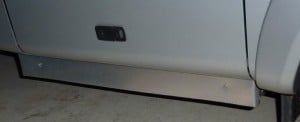 Satin Aluminum Generator Trim – When we picked up our Unity the green of the Onan
Satin Aluminum Generator Trim – When we picked up our Unity the green of the Onan
generator extended below the cargo bay doors. We cut a piece of lightweight aluminum to cover the generator and attached it with screws in the generator. This small piece of trim has an appropriate satin sheen and looks like it is part of the de- sign. It hides the generator and contributes to the overall appearance of our Unity.
Deletion of stripes and graphic identification – Rationale: Uncluttered design. I’m a “car guy” and like clean, uncluttered design. 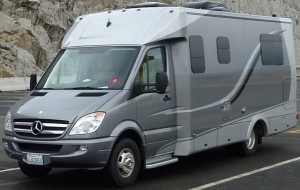 The Unity is about as attractive as an RV can be but we make it even better by deleting the top stripes and all of the graphic identification. The result is an extremely clean design that gives a unique upscale appearance. We have become accustomed to people telling us what an attractive RV we have and asking who made it. I think Leisure Travel gets more mileage out of our Unity than if it looked like all of the others on the road.
The Unity is about as attractive as an RV can be but we make it even better by deleting the top stripes and all of the graphic identification. The result is an extremely clean design that gives a unique upscale appearance. We have become accustomed to people telling us what an attractive RV we have and asking who made it. I think Leisure Travel gets more mileage out of our Unity than if it looked like all of the others on the road.
Heated Tanks – Rationale: Four season use. One of our goals was a four-season RV, but it seemed that there were none.  Then we talked to Dave Strawser at Creston RV who wondered if Leisure Travel would install heated tanks as sometimes used on large, upscale coaches. Heated tanks went on our specification list and were approved for production.
Then we talked to Dave Strawser at Creston RV who wondered if Leisure Travel would install heated tanks as sometimes used on large, upscale coaches. Heated tanks went on our specification list and were approved for production.
On our trip home from Winkler we found ourselves spending a night at 11 degrees
(Fahrenheit). We were plugged in at my brother’s house in Bentonville, Arkansas, so a flip of the switch turned on the heated tanks. The next morning all systems were normal and nothing was frozen. We had a comfortable night thanks to the Unity’s effective insulation and design, the heated tanks and the quiet and efficient furnace (which is unobtrusive when it cycles in the middle of the night). The design and con- struction of our IB give us a four-season B+ in which we can travel year-round with comfort and without worry.
Inverted Outlets – Rationale: Convenience.  We thought the inverter should have more uses than the entertainment system so we considered other uses and how much current each would draw. Although we inquired about a lar- ger inverter, we found that the standard inverter provided ade- quate power to grind coffee, charge my computer, and run a few other small appliances. The result was a request to have two outlets wired to the inverter circuit.
We thought the inverter should have more uses than the entertainment system so we considered other uses and how much current each would draw. Although we inquired about a lar- ger inverter, we found that the standard inverter provided ade- quate power to grind coffee, charge my computer, and run a few other small appliances. The result was a request to have two outlets wired to the inverter circuit.
Although this specification was inadvertently overlooked in the build process, Brad had the outlet at the foot of the bed rewired and a hole drilled in the top shelf in the overhead compartment on the far right of the galley so I could get access to the inverted plug behind the control box. I plugged a two-foot four-outlet cord into the box and use the outlets for sev- eral low-draw applications. It works well.
Aftermarket Additions & Modifications
Alcoa Alloy Wheels – These were admittedly bought for appearance and they definitely give our Unity an up-scale look that is appropriate for the Mercedes Sprinter chassis.  Eventually the small Alcoa decal in the center of each wheel will be replaced by a round Mercedes emblem.
Eventually the small Alcoa decal in the center of each wheel will be replaced by a round Mercedes emblem.
Interestingly, the wheels have a small but noticeable impact on the steering that I probably would never have noticed if we hadn’t driven our first 9,000 miles or so with the standard steel wheels. Soon after the Alcoa wheels were installed we took a week-long trip and immediately noticed that the steering was slightly easier. Although the Sprinter steering is quite good with the standard wheels, it is slightly better with the Alcoas. My first thought was, “Why?”
 When we got home I talked to the manager at the shop that installed our wheels and did some research online. The differ- ence appears to be the reduced rotating weight of the alloy wheels. The Alcoa wheel website, which focuses primarily on wheels for commercial over-the-road truck use, mentions re- duced fuel consumption and maintenance due to the reduced weight. These would be minimally relevant in an RV application, but the steering is slightly better and they do look cool.
When we got home I talked to the manager at the shop that installed our wheels and did some research online. The differ- ence appears to be the reduced rotating weight of the alloy wheels. The Alcoa wheel website, which focuses primarily on wheels for commercial over-the-road truck use, mentions re- duced fuel consumption and maintenance due to the reduced weight. These would be minimally relevant in an RV application, but the steering is slightly better and they do look cool.
Since the Unity is positioned at the high end of B+ coaches, the Alcoa wheels dress it up quite nicely and seem appropriate.
TPMS System – Tire pressure monitoring systems (TPMS) are standard only on vehicles under 10,000 GVW.  I added one to our Unity because tire problems with RVs often are the result of something that occurs while on the road and isn’t detected until too late. The system will pay for itself the first time it detects a low tire. In the morning as we prepare to get on the road, I press a button on the TPMS monitor and run through the tire pressures just to be sure the tires are inflated as they should be.
I added one to our Unity because tire problems with RVs often are the result of something that occurs while on the road and isn’t detected until too late. The system will pay for itself the first time it detects a low tire. In the morning as we prepare to get on the road, I press a button on the TPMS monitor and run through the tire pressures just to be sure the tires are inflated as they should be.
Stainless Steel Exhaust Tips – 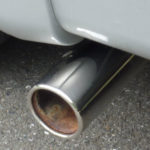 These took a bit of searching to find the sizes that fit nicely. The larger polished stainless tip (12” long by 3” ID, 3.5” OD) has a straight cut end and bolts on snuggly with a small piece of exhaust manifold wrap between the exhaust pipe and tip. A smaller stainless tip is on the generator exhaust. These en- hance the appearance and are appropriate for an up-scale RV. They were a good use of $32.
These took a bit of searching to find the sizes that fit nicely. The larger polished stainless tip (12” long by 3” ID, 3.5” OD) has a straight cut end and bolts on snuggly with a small piece of exhaust manifold wrap between the exhaust pipe and tip. A smaller stainless tip is on the generator exhaust. These en- hance the appearance and are appropriate for an up-scale RV. They were a good use of $32.
Third Bed in an IB – Deleting the table eliminated the third bed which we didn’t envision using.  Then we found we needed the bed when a friend joined us for a two-day bicycle ride with Celia driving the Unity as our support crew. What to do? I looked at temporarily adding the table then, after taking a few measurements, decided that a piece of 3/4″ plywood cut to fit snugly between the two facing seats would be a satisfactory bed platform. I cut the plywood for a snug fit then tested it by sitting in the center. It didn’t even flex and was perfectly stable. Our friend had a good bed and the next morning the plywood stashed quickly in the rear pass-through compartment. The ply- wood is now stored awaiting its next use.
Then we found we needed the bed when a friend joined us for a two-day bicycle ride with Celia driving the Unity as our support crew. What to do? I looked at temporarily adding the table then, after taking a few measurements, decided that a piece of 3/4″ plywood cut to fit snugly between the two facing seats would be a satisfactory bed platform. I cut the plywood for a snug fit then tested it by sitting in the center. It didn’t even flex and was perfectly stable. Our friend had a good bed and the next morning the plywood stashed quickly in the rear pass-through compartment. The ply- wood is now stored awaiting its next use.
Leveling system – 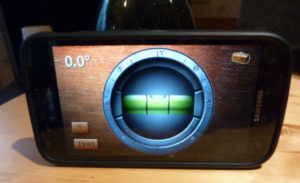 Leveling an RV without jacks was a new experience for us. I looked at leveling blocks of various types and read several articles on leveling. Ultimately I developed a quick solution with the help of a leveling app on my smart phone and several pieces of 2×6 I had around.
Leveling an RV without jacks was a new experience for us. I looked at leveling blocks of various types and read several articles on leveling. Ultimately I developed a quick solution with the help of a leveling app on my smart phone and several pieces of 2×6 I had around.
When we pull into a camp site, I set my phone on the top of the counter in the galley. The
leveling app gives a reading in .1 degrees. 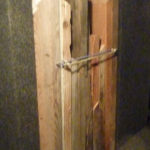 I check the level side-to-side and front-to-back.
I check the level side-to-side and front-to-back.
Experimentation found that one block (1.5”) corrects for approximately .8 degrees side-to-side
and .4 degrees front-to-back. When I look at the level I have a very good idea where I need blocks and how many. We are level within 1 degree in both directions in just a couple of
minutes. I have nine blocks in four lengths so I can adjust to quite a variety of situations but
we have never encountered the need for more than two blocks on any corner. The blocks store compactly in a vertical space in the rear cargo bay. They fit perfectly in space that would other- wise be unused and weigh very little, A small bungee cord holds them securely so they ride securely and stay in place.
Galley Drawer Tray – When we were visiting a friend in California he showed me a tray he bought for their RV to improve space utilization in galley drawers. 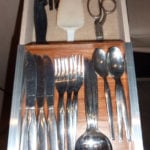 This seemed like such a good idea that I designed a simi- lar sliding tray for two of our galley drawers. The trays holds small frequently used items making them more accessible and using space in the drawer more effectively. The aluminum rails slide smoothly on the top of the drawer. The base of the tray is 1/8” plywood so it doesn’t take much space. In the case of the shallow top drawer, the tray height was set to divide the drawer height in half.
This seemed like such a good idea that I designed a simi- lar sliding tray for two of our galley drawers. The trays holds small frequently used items making them more accessible and using space in the drawer more effectively. The aluminum rails slide smoothly on the top of the drawer. The base of the tray is 1/8” plywood so it doesn’t take much space. In the case of the shallow top drawer, the tray height was set to divide the drawer height in half.
Standardized Colors on Top – 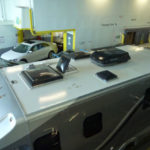 When we received our Unity the air conditioner and most of the other things on top of the coach were black. One vent and the TV antenna, however, were white and looked out of place. With some careful masking and the application of automotive-grade plastic paint, everything on top is now black and looks like it is in harmony.
When we received our Unity the air conditioner and most of the other things on top of the coach were black. One vent and the TV antenna, however, were white and looked out of place. With some careful masking and the application of automotive-grade plastic paint, everything on top is now black and looks like it is in harmony.
Accessories We Added
Indoor/Outdoor Thermometer – 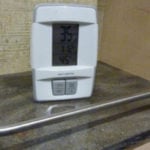 In cold weather I’m always concerned with the outside temperature. At home I have an indoor/outdoor thermometer. How would this apply to our Unity? The solution was simple: put the outdoor temperature sensor in the rear storage bay. It seems to work quite well and it gives me the high and low for the past 24 hours.
In cold weather I’m always concerned with the outside temperature. At home I have an indoor/outdoor thermometer. How would this apply to our Unity? The solution was simple: put the outdoor temperature sensor in the rear storage bay. It seems to work quite well and it gives me the high and low for the past 24 hours.
Remote Thermostat for Electric Heater – 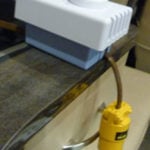 I saw this as a tip on the daily RVTravel.com tip sheet I receive. You use a thermostat designed for electric baseboard heaters and basically insert it in a short extension cord to which you plug a small electric heater that many RVers use when they are plugged in. The setup in the tip I received appeared to have electrical tape over the back of the thermostat but I took the design one step further and mounted the thermostat to a shallow plastic electrical box for a finished ap- pearance. It works well.
I saw this as a tip on the daily RVTravel.com tip sheet I receive. You use a thermostat designed for electric baseboard heaters and basically insert it in a short extension cord to which you plug a small electric heater that many RVers use when they are plugged in. The setup in the tip I received appeared to have electrical tape over the back of the thermostat but I took the design one step further and mounted the thermostat to a shallow plastic electrical box for a finished ap- pearance. It works well.
Cargo Carrier – 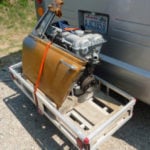 I needed to get a Mazda Miata engine and an MG Midget door from Bellingham to my son in Tulsa. Freight was going to cost almost $600. When I saw an ad for a 500 lb. capacity cargo carrier, I investigated the feasibility. The engine was relatively light and we just barely stayed within the GVWR. This is almost surely a one-trip item for us as we have no plans for future use, but it certainly was convenient for this application.
I needed to get a Mazda Miata engine and an MG Midget door from Bellingham to my son in Tulsa. Freight was going to cost almost $600. When I saw an ad for a 500 lb. capacity cargo carrier, I investigated the feasibility. The engine was relatively light and we just barely stayed within the GVWR. This is almost surely a one-trip item for us as we have no plans for future use, but it certainly was convenient for this application.
Comments on potential additions and modifications
Attesting to the quality design of the Unity and how well it fits our travel style, our 16,815 miles and almost 100 days of use (two six-week trips and five shorter trips) have left us with very few areas where we can offer suggestions.
Two of the items on our list have already been addressed in your 2014 updates (the Premium Cab and Dropdown Table). The remaining list is short and many of them may not be feasible.
Switch for the electric hot water – The electric hot water switch is accessible only outside. It would be much more conven- ient if there was a switch on the control panel over the door.
Wire the galley outlet (or others) to the inverter, perhaps with a slightly larger inverter – The standard inverter is useful for much more than the entertainment system. While uses are limited by the size of the inverter and battery capacity, the system still can still handle many small appliances when boondocking. To avoid exceeding the inverter capacity, we have a small tester to measure the wattage draw of anything plugged into it.
Carpet for the entry step – Our Unity came with a piece of carpet on the inside step that matched the carpet in the Sprinter cab. Cut rather roughly, it didn’t appear to be part of the design. We trimmed ours neatly and find it very useful. Cutting and bind- ing a piece of carpet for this step, perhaps securing it with Velcro, would be a nice utilitarian and appearance touch.
Wire the light in front of the shower with the bedroom rather than the living area – When one person is up and one is sleeping in, the person up front may close the bedroom door but when the lights in the forward area are turned on the light in front of the shower is on so that effectively there is light in the bed- room. It would be better if this light was wired with the bedroom.
Leveling jacks – I’ve read a few things about leveling jacks for Sprinters. I’m sure there would be several issues, among them weight. But if it was feasible, they would be a nice option.
Four-season classification – Our IB is set up to serve as a four season coach. Would “certifying” it as a four season coach be a “first” in Sprinter-based RVs and something unique and wor- thy of promoting?
Comments on changes for 2014
We watched the online video of changes for 2014 and took note of several for comments. One note on the video: When Dean sets up the third bed in the IB, the back cushions of the seats need to be reversed to make a flat bed.
Dropdown table to right of counter – We requested this as an option but the request was denied. It seemed like such a logi- cal idea in a galley with restricted space. Apparently someone else agreed. We would like to buy one and add it to our Unity.
Premium cab option – I asked about this but it wasn’t avail- able. One person I talked to said the Unity was expensive enough already and nobody would buy it. I’d venture that the majority of people buying a new Unity have cars with the features included with the premium cab option and would like to have these features in their RV. The Unity is positioned at the premium end of the B+ segment and had the option been available I would have bought it. A premium RV deserves a premium cab.
Lower bed – I can tell that this was made possible by deleting the “make-up table” (what I have always referred to as my “computer workstation”) but given the choice I’m glad I have a 2013 with my workstation. I suspect more people would prefer the lower bed, however.
Shades – The new shades look interesting and Celia likes them a lot.
Galley Window – One update not mentioned in the video is the galley window which is significantly larger. That’s a nice im- provement as I don’t think you can ever have too many windows.
Overall – Continuing to improve the product is an important part of remaining competitive. With the choice of four floor plans, each targeting different needs, the Unity is positioned at the top of its class. The quality is there and we absolutely love ours.


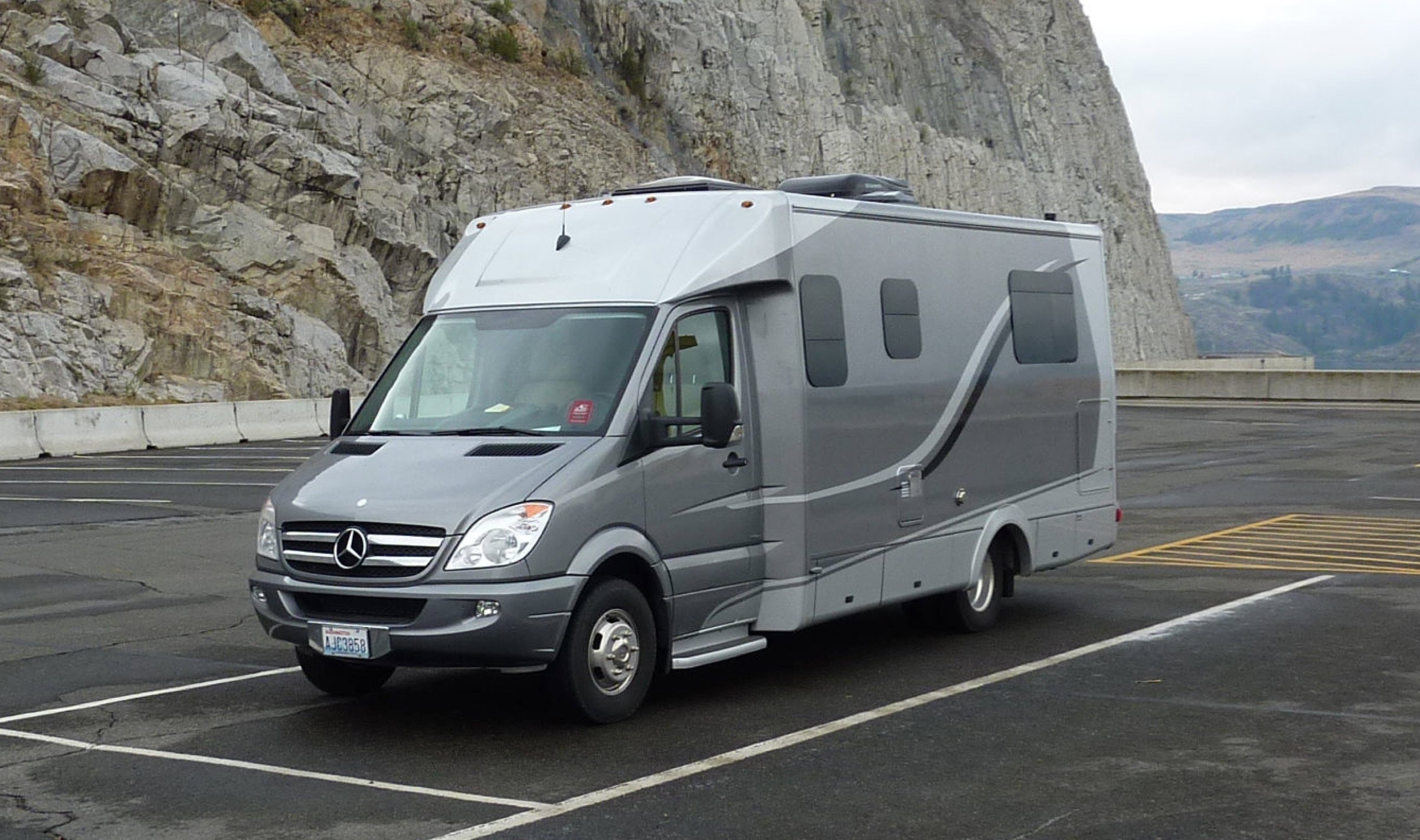


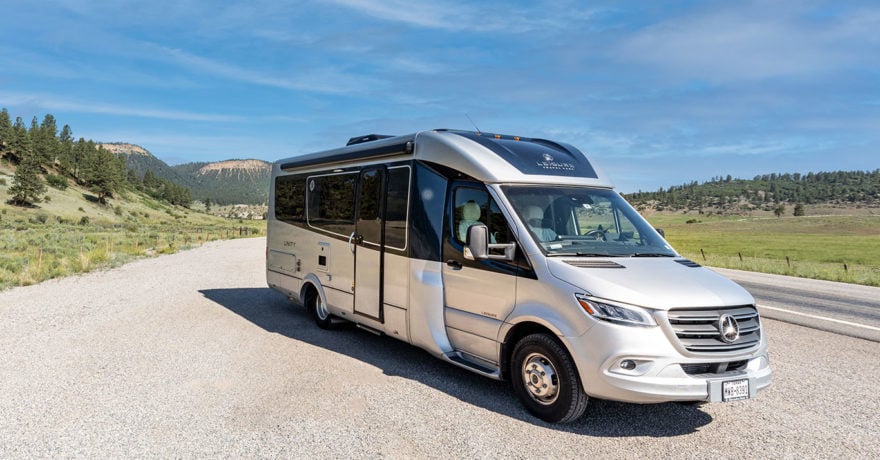
Comments